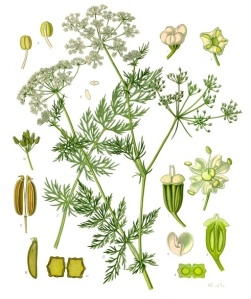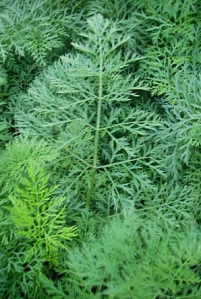There is a plant I keep encountering, both on foraging trips and while out running, and for a long time I had been entertaining the hope that it was wild carrot (Daucus carota), while secretly suspecting that it was actually poison hemlock (Conium maculatum). These two members of the Apiaceae/Umbelliferae family look very similar as young plants (and both are sometimes called Queen Anne’s lace), but armed with Samuel Thayer’s “Nature’s Garden” on our recent Redwood Park foraging trip, I was able to pin down once and for all that…dammit, yes: it’s hemlock.

Poison hemlock, Conium maculatum. Not the wild carrot I was hoping for. Photo courtesy of Jen at willblogforfood.
The Apiaceae are a fickle lot of plants: some are friendly foodstuffs (carrot, fennel, celery, parsley, caraway), some are vicious poisons (poison hemlock, water hemlock, fool’s parsley), and some are something in between (like cow parsnip, which is edible but whose sap can be a strong irritant). Several of them look similar as young plants, too, with rosettes of feathery leaves and umbels of delicate white flowers.

Caraway, Carum carvi. If I hadn’t read the title, I might have thought it was fennel, because all these darn Apiaceae look similar. From Koehler’s Medizinal Pflanzen.
Over the centuries, many people have been poisoned by mixing them up. A handful of case studies from the last decade of folks who ate a variety of toxic Apiaceae can be found here, here, here, and here. For those who forage, wild wood survival offers a sturdy guide to telling tasty wild carrot from its toxic doppleganger. (Quick and dirty version: hemlock has smooth stems, sometimes speckled purple or with a chalky residue. It doesn’t smell very good, and its flowers are loosely packed in umbels, like caraway, above. Wild carrot has fuzzy stems, smells strongly of carrot, and has tightly-packed umbels of flowers with one dark purple flower in the middle. And if you’re in doubt, don’t eat it!)

Wild carrot, Daucus carota. Similar enough to C. maculatum to give you pause, and make you wish you’d brought some store-bought carrot leaves along for comparison. Photo from Gunther Blaich’s website.
And then, of course, there are the more sinister, deliberate poisonings.
In ancient Greece and Rome, hemlock was used as a method of execution and of suicide. Its most famous victim was Socrates (the poet Seneca the Younger was probably second-most-famous), who chose to drink an infusion of hemlock rather than leave Athens for the crimes of heresy and corruption of youth. Being the thoughtful guy he was (and more of an empiricist than his academic descendant Aristotle, who basically just decided to make up a bunch of scientific rules rather than actually observe how things worked, leading to hundreds of years of entrenched misinformation about mechanics, taxonomy, and medicine, but I digress…), Socrates gave a running account of the symptoms he experienced as the hemlock infusion overtook his body, chronicled in Plato’s Phaedo:
“The man…laid his hands on him and after a while examined his feet and legs, then pinched his foot hard and asked if he felt it. He said “No”; then after that, his thighs; and passing upwards in this way he showed us that he was growing cold and rigid. And then again he touched him and said that when it reached his heart, he would be gone.”
As a case-study, the death of Socrates offers some insight into the mechanistic basis of hemlock poisoning: it seems to interfere with communication between nerves and muscles, leading to loss of sensation and paralysis. In recent years, this has been defined more precisely. The main poison in C. maculatum is coniine (although there are several others), an alkaloid that causes neuromuscular blockage in humans and in grazing animals (but curiously seems to be somewhat less toxic to birds, needing a higher dose per weight for toxicity). It causes death when the neuromuscular junctions affected include those of the heart, arteries, and the muscles needed to breathe.
Extra nitty-gritty:
Coniine is part of the nicotinic class of aklaloids (along with, you guessed it, nicotine). They work by modifying the function of cholinergic neurons, the ones that use acetylcholine as a neurotransmitter. What’s kind of cool about nicotinic alkoloids is that they have two phases of effect (reviewed in this paper), which seem contradictory: in the first phase, the alkaloid stimulates the cholinergic receptor, leading to symptoms like high blood pressure, increased heart rate, and tremors. In the second phase, the alkaloid’s effect on cholinergic receptors is inhibitory, with opposite effects: slowed heart rate, reduced blood pressure, and eventually, coma or death. The relative contribution of the two phases to the overall symptoms depends on the alkaloid, the dose, and the time of exposure, which is why some alkaloids, like nicotine, give primarily agonistic (stimulant) effects, and others, like coniine, give primarily antagonistic (depressive) effects.
In pre-modern era medicine, the depressant and numbing effects of coniine were taken advantage of, and hemlock was sometimes added to the “soporific sponge” a collection of herbs used as an early form of anesthesia. But although coniine might seem to be an appealing anesthetic or analgesic, because it certainly blocks pain messages from reaching the brain, it’s not actually very useful in modern medicine because its therapeutic index is so narrow: the amount it takes to have an analgesic effect is very close to the amount it takes to kill you. The only thing coniine has in its favor as a poison is that the effects will eventually wear off, and for the various veterinarians who have had to contend with sheep or cows that have eaten hemlock, the trick is to fend off the coma and respiratory failure long enough for the coniine to wear off.

Use of the soporific sponge in 13th century Arabic anesthesiology, in which herbs including opium, mandrake, and hemlock might be combined and inhaled by the patient during surgery. From Takrouri, 2010, Figure 1 (see link, below).
Recently, a new toxin was found in hemlock, which the authors of the study called conmaculatin. Like coniine, it has anticociceptive (pain-inhibiting) activity in mice, but also like coniine, the amount it took to prevent pain (10-20mg/kg) was very near the amount it took to kill the mouse (>20mg). So no great therapeutic help there. It does make me wonder if there’s the potential for a little biochemical wrangling here though–maybe some slight tweaking of the receptor affinity would give you a drug that could block receptors in the peripheral nervous system for pain relief, without blocking the neuromuscular junctions in the muscles needed for respiration and cardiovascular function. I can’t help but think that so many of our approaches to pain management rely on opioid receptors, with all of the potential for abuse that entails. Maybe some neurobiologist out there can weigh in on the potential for cholinergic receptors as a site of pain management?
Want more detail? Here are references:
The Poison Garden has an excellent article on hemlock.
Takrouri MM. Historical essay: An Arabic surgeon, Ibn al Quff’s (1232-1286) account on surgical pain relief. Anesth Essays Res [serial online] 2010 [cited 2012 May 8];4:4-8. Available from: http://www.aeronline.org/text.asp?2010/4/1/4/69298
Schep LJ, Slaughter RJ, & Beasley DM (2009). Nicotinic plant poisoning. Clinical toxicology (Philadelphia, Pa.), 47 (8), 771-81 PMID: 19778187
Radulović N, Dorđević N, Denić M, Pinheiro MM, Fernandes PD, & Boylan F (2012). A novel toxic alkaloid from poison hemlock (Conium maculatum L., Apiaceae): identification, synthesis and antinociceptive activity. Food and chemical toxicology : an international journal published for the British Industrial Biological Research Association, 50 (2), 274-9 PMID: 22063758



I went googling for an image of young wild carrot leaves and came across your post. Excellent summary of a very interesting topic – thanks so much for taking the time to write!
Thanks for the kind words and for stopping by!
Pingback: Toxic and toothsome: a tale of two wild Asteraceae | A bouquet from Mendel
Pingback: Wild carrots at last! | A bouquet from Mendel